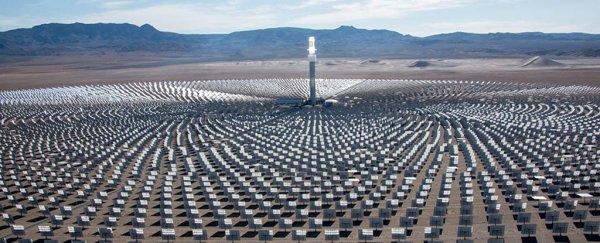The onward march of renewables continues: an Australian state government has greenlit the biggest solar thermal power plant of its kind in the world, a 150-megawatt structure set to be built in Port Augusta in South Australia.
As well as providing around 650 construction jobs for local workers, the plant will provide all the electricity needs for the state government, with some to spare – and it should help to make solar energy even more affordable in the future.
Work on the AU$650 million (US$510 million) plant is getting underway next year and is slated to be completed in 2020, adding to Australia's growing list of impressive renewable energy projects that already cover solar and tidal.
"The significance of solar thermal generation lies in its ability to provide energy virtually on demand through the use of thermal energy storage to store heat for running the power turbines," says sustainable energy engineering professor Wasim Saman, from the University of South Australia.
"This is a substantially more economical way of storing energy than using batteries."
Solar photovoltaic plants convert sunlight directly into electricity, so they need batteries to store excess power for when the Sun isn't shining; solar thermal plants, meanwhile, use mirrors to concentrate the sunlight into a heating system.
A variety of heating systems are in use, but In this case, molten salt will be heated up – a more economical storage option than batteries – which is then used to boil water, spin a steam turbine, and generate electricity when required.
The developers of the Port Augusta plant say it can continue to generate power at full load for up to 8 hours after the Sun's gone down.
The Crescent Dunes plant in Nevada will act as the blueprint for the one in Port Augusta, as it was built by the same contractor, Solar Reserve. That site has a 110-megawatt capacity.
Renewable energy sources now account for more than 40 percent of the electricity generated in South Australia, and as solar becomes a more stable and reliable provider of energy, that in turn pushes prices lower.
Importantly, the cost of the new plant is well below the estimated cost of a new coal-fired power station, giving the government another reason to back renewables. The cost-per-megawatt of the new plant works out about the same as wind power and solar photovoltaic plants.
But engineering researcher Fellow Matthew Stocks, from the Australian National University, says we still have "lots to learn" about how solar thermal technologies can fit into an electric grid system.
"One of the big challenges for solar thermal as a storage tool is that it can only store heat," says Stocks. "If there is an excess of electricity in the system because the wind is blowing strong, it cannot efficiently use it to store electrical power to shift the energy to times of shortage, unlike batteries and pumped hydro."
Authorities say 50 full-time workers will be required to operate the plant, using similar skills to those needed to run a coal or gas station. That will encourage workers laid off after the region's coal-fired power station was closed down last year.
Solar thermal has been backed to the tune of AU$110m ($86m) of equity provided by the federal government.
And as renewables become more and more important to our power grids, expect to see this huge solar thermal plant eventually get eclipsed by a bigger one.
"This is first large scale application of solar thermal generation in Australia which has been operating successfully in Europe, USA and Africa," says Saman.
"While this technology is perhaps a decade behind solar PV generation, many future world energy forecasts include a considerable proportion of this technology in tomorrow's energy mix."
